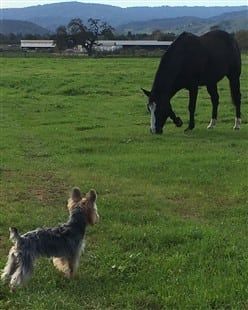Yorkshire Terrier Vomiting Issues
Overview
It’s always concerning when a little Yorkie starts vomiting; even one episode can take a toll on this tiny toy breed. There may be acute or chronic vomiting, and this may occur with or without other signs such as diarrhea. Vomit may be white, foamy, or consist of partially digested or regurgitated food. Some dogs may appear completely normal both before and after throwing up, but others may show signs of not feeling well including lethargy and decreased appetite.
In all cases, quick action should be taken; this includes identifying the cause, helping to calm down a queasy stomach, and rehydrating a Yorkie before dehydration develops.
This section will cover types of vomiting, the top reasons why this may happen, how to treat your Yorkshire Terrier from home, and red flag reasons that warrant a veterinarian visit.
Please note:
YorkieInfoCenter is reader-supported, and some of the product suggestions on this page are affiliate links. As an Amazon Associate we earn from qualifying purchases. This is at no extra cost to you and helps us continue providing free, high-quality information.
Defining What is Happening

Olive, at 6 months old,
photo courtesy of Marlene London
Nausea
– Refers to a queasy stomach. A dog can feel nauseous without vomiting. However, if a dog does throw up, he often has nausea first. An example of when Yorkies feel nauseous is when car sick; they may whine or appear restless, and/or hunch over readying to throw up.
Dry heaving
– Also referred to as retching, this is the contraction of stomach muscles and the physical reflex of the stomach that causes lurching yet without any substance being expelled. This may occur on its own if there is no food or drink in a dog’s stomach, or a dog may dry heave after a severe bout of vomiting once there is nothing left to expel.
Vomiting
– The involuntary ejection of stomach contents, and sometimes contents from the small intestine, which will include partially digested food and/or stomach bile, up through the esophagus (the tube connecting the throat and the stomach) and out of the mouth.
Regurgitation
– The backflow of food, not from the stomach, but from the esophagus and out of the mouth. The food will not be partially digested at all, as it did not yet enter the stomach. This happens quickly, and there is no preceding nausea. If your Yorkie throws up his food immediately after eating it and it looks very similar to how it looked before he swallowed it, your dog is most likely regurgitating.
Expectorating
– This is always seen alongside coughing.
A dog may hunch over and/or gag, appearing as if he is vomiting, however the contents are mucus from the lungs and/or windpipe, and in some cases food (if it went down the wrong way). This will be coughed up and expelled from the mouth.
Other Common Symptoms Seen Alongside Vomiting
Vomiting can be the only symptom. However, a Yorkshire Terrier may also have one, some, or all of the following:
- Drooling
- Restlessness
- Panicked behavior
- Panting
- Shivering, shaking
- Lethargy
- Decreased appetite
- Refusal to drink
- Dehydration
- Excessive thirst
- The presence of white foam
- The presence of yellow bile
- Diarrhea
- Fever
- Weight loss (seen in chronic cases)
Note:
More serious signs seen alongside vomiting will be covered ahead as we go over some of the possible causes.
When a Yorkie Vomits Right After Eating
What's happening:
A Yorkshire Terrier may randomly throw up his food immediately after eating it, or vomit out water right after lapping it up, shocking you a bit and leaving you wondering what in the world made that suddenly happen. Alternatively, your Yorkie may throw up his food quite often, leaving you just as baffled.
If this happens within just a minute or so after eating a meal, this is actually a regurgitation, a term that we defined earlier. The food never reached the stomach; it came back up too quickly.
Common reasons for a Yorkie regurgitating food are:
- Eating too quickly
- Eating too much at one time
- Food intolerance
Less common, but possible health reasons include:
- Congenital issues with the throat and/or esophagus
- Acquired issues including internal growths, or the presence of a foreign body in the esophagus
- Diseases including cancer, tumors, megaesophagus (enlarged esophagus), and esophageal stricture (abnormal narrowing of the esophagus).
Signs of these serious conditions include change in tone of bark, loss of bark, raspy or loud breathing, exercise intolerance, blue tint to the gums, coughing, nasal discharge, changes in appetite, chronic or severe bad breath, trouble eating (whining, reluctance), lethargy, and/or extreme weight loss.
What to do:
1. If you suspect any of the aforementioned possible serious health issues
that can cause regurgitation, this warrants an immediate vet visit.

However, there are some safeguards you can put into place:
- Do not place the bowl down if your Yorkie is revved up; this is common if a dog has been running around, and then is called to dinner. Serve meals when your Yorkie is calm.
- Split the day’s food into 3 small meals. This is always recommended for this breed to help prevent hypoglycemia. If you will be gone during the day, you can place your Yorkie’s lunch into a treat-release toy
to be eaten while you are away.
- Only serve the amount that is needed. How much a Yorkie should be fed at each meal will vary depending on which type of food you are giving to your dog. If you are feeding your Yorkie manufactured food, the instructions on the labeling are usually pretty spot on; these are based on age and weight. In general, for dry kibble, a 2-lb. adult Yorkie will eat 1/4 cup per DAY, a 4-lb. adult about 1/2 cup, and an 8-lb. adult about 3/4 cup.
- Use a portion pacer. A popular way to encourage slow eating is via use of a slow-feeder bowl, however, it is really hard to find one that is small enough for a Yorkshire Terrier and made of stainless-steel; Tiny ones are usually made of plastic, but due to chance of contact allergies and other issues like scratches that harbor bacteria, you’ll want to avoid any sort of plastic bowls for food or water.
So, a stainless-steel portion pacer, like the Omega Paw Portion Pacer in size Smallcan work well. This is placed in the food and/or water bowl.
4. For food intolerance, there are two aspects of this in regard to regurgitation.
One is the unplanned ingestion a certain food; for example, food meant for human consumption that fell to the floor, especially something overly greasy, or spoiled food from the trash. If it is vomited up immediately after eating it, and you know that it was not toxic, this will be a short-lived event that does not require treatment.
The other refers to an intolerance to something in a Yorkie’s regular diet. It may be a matter of the size of the kibble; Yorkshire Terriers should have a kibble geared for toy or small breeds. It may be a matter of the consistency or texture. Or it may be an ingredient in the food. Ahead, we will go into more detail about some of the best choices for foods, in the Treating a Yorkie for Vomiting
section.
When a Yorkie Vomits Yellow Liquid and/or White Foam

This is a common problem with this tiny toy breed and may occur with a Yorkshire Terrier of any age. This may happen at any time during the day or night, but typically does not occur within one to two hours after a meal.
Yellow liquid that is thrown up will rarely contain any food particles, and it will vary in consistency from thin to thick. There may be white foam surrounding the puddle of yellow fluid, or white foam may be vomited out separately.
If your Yorkie is throwing up yellow liquid, this is stomach bile. Bile refers to the liquid substance that the body makes to help digest food. It contains a mixture of water, salts, fats, and mucus.
The most common reason for a Yorkshire Terrier vomiting up yellow liquid with or without white foam is that the stomach is too empty. Without any food to serve as cushioning, and with a buildup of bile ready to digest food that it is not receiving, this can accumulate and be vomited out.
Rare, but possible, is health issue such as gastritis or inflammation of the stomach or intestine.
Other signs of gastritis include decreased appetite, increased thirst, lethargy, diarrhea, depression, blood in vomit or in the stools, and/or black tarry stools.
Other signs of stomach or intestinal inflammation include vomiting up undigested food with dried blood (resembles coffee grounds), diarrhea, dark stools, stools with mucus, straining to push out a bowel movement, decreased appetite, weight loss, and/or signs of abdominal pain.
What to do:
1. If you suspect any of the aforementioned possible serious health issues
that can cause vomiting of yellow liquid or white foam, this warrants an immediate vet visit.
2. Offering more frequent meals and snacks
can cure this almost immediately, since this most often caused by infrequency of food intake.
This breed should have a minimum of 3 meals per day; this goes for puppies and adults alike. However, this often is not enough to keep bile at bay; snacks throughout the day
are needed as well.
Keep in mind that when you see serving instructions on a bag of kibble, this is a suggestion based on the assumption that a dog will be receiving daily treats as well.
In addition, snacks given to keep a dog from throwing up bile do not need to be substantial. Just a tiny mini-cracker or two, given 3 to 4 times per day in between meals is often enough to remedy things.
Be sure to offer your Yorkie 'dessert', via a treat, about 2 hours after dinner.
If your Yorkshire Terrier vomits up yellow bile first thing in the morning, offer 1 to 3 treats right before your puppy or dog falls asleep.
If your Yorkie typically wakes up before you, have a few treats placed near his bed, easy to see and reach, that he may munch on immediately upon waking up.
If your Yorkie does not seem all that hungry or eager to eat any extra, you can:
- Slightly decrease the amount given at meal time, to make room in the day’s overall appetite.
- Give treats in response to good behavior such as obeying a command. Many dogs will chomp down on a yummy bite of food if it is clear that it is given as a reward.
- Take time to offer extra-delicious treats. Often, appetite is related to desirability of food. A great choice is Old Mother Hubbard Classic Crunchy Mini Biscuits Treats
, which are 100% all-natural, with no chemical preservatives or artificial flavoring. These are dry, mini crackers, and are perfectly sized for rewards and to cushion the stomach a bit. And, these are made in the USA.
When a Yorkie Vomits During or Right After Exercising
In these situations, a Yorkshire Terrier will eat a meal, or a good-sized snack, and then typically under an hour later will be running around playing or be briskly walking, when he suddenly throws up. There will generally be no signs of discomfort beforehand with nausea or queasy stomach issues, and most dogs bounce back rather quickly afterward.
The most common reason for this happening is a simple case of food not having a chance to settle down before the body is engaging in a high-energy, demanding activity.
What to do:
1.
Limit activity until at least 1 hour after meal time. For Yorkies that seem to have slow digestive systems, this may need to be extended to 1.5, or even 2 hours. Do not, however, skip regular walks, if at all possible; daily exercise
is a vital part of maintaining good health.
2.
Note that limiting activity relates to long, good-paced walks or rousing games of fetch, and does not include normal every day activities such as being brought outside for bathroom needs.
3.
If your Yorkshire Terrier is still having issues, it’ll be time to look to other causes for vomiting; it may have been coincidental that it was occurring during times of exercise.
When a Yorkie is Dry Heaving

Dixie (4 months) and Theodore (1 year old),
photo courtesy of J & Rick Geffken
Aside from dry heaving, other signs include a visibly distended abdomen, restlessness, panic, heavy breathing, pale gums, increased heart rate, weakness, and/or excessive drooling. If this is suspected, immediately seek emergency veterinary intervention and treatment.
Respiratory infection, including Kennel Cough
– If there is excessive mucus in the lungs, this often causes coughing and gagging, which can easily lead to dry heaving. Other signs include chronic cough, wheezing, rapid breathing, runny nose, sneezing, exercise intolerance, lethargy, decreased appetite, and/or fever.
Tonsillitis
– An infection of the tonsils is possible with canines, but is almost always a secondary condition that develops after a bout of chronic cough, chronic vomiting, periodontal disease, or other issues.
While this may not cause dry heaving during the early stages, once the tonsils become so enlarged that they partially block the airway, dry heaving can be intense. Other signs include reluctance to eat and/or frequent lip licking.
The treatment for this involves resolution of the initial issue as well as antibiotics to treat the tonsillitis. It is exceptionally rare for a dog to need to have his tonsils removed, and it is only done in cases of highly reoccurring infections.
Obstruction in the esophagus or throat
- What may be lodged and partially blocking a dog’s breathing passages range from hairballs (canines can indeed get these too) to a foreign object being swallowed.
Retching may release the object; however, it is very important to monitor your Yorkie for signs of breathing impairment, including weakness and/or pale or blue gums. Dry heaving that is not productive is also a reason for immediate veterinary treatment. When in doubt, bring your Yorkie to the closest animal hospital.
When a Yorkie Has Bloody Vomit with or without Bloody Diarrhea

Chiqui, at 2 years old,
photo courtesy of Keith Canlapan
When a Yorkie Has Violent, Projectile Vomiting
This refers to explosive, severe vomiting in which there is enough force for the contents to be expelled over a significant distance. With this, most dogs will be standing, the neck will be fully extended, and the contents of the stomach will be expelled almost violently, leaving a dog breathless, and often shaking or shivering uncontrollably.
This is considered to be a very serious condition that requires immediate veterinary care, and there are two reasons for this.
One, the cause of projectile vomiting may be quite serious; top reasons include intestinal blockage, poisoning, head injury, or even pancreatitis.
The other reason is because toy breeds like the Yorkshire Terrier become dehydrated very quickly. With ‘normal’ vomiting, there is always a concern of dehydration, but dogs will generally drink or even try to eat, so this can often be avoided. But, with projectile vomiting, so much fluid is lost at one time, and dogs are rarely willing or able to rehydrate, thus a serious case of dehydration can occur very quickly.
When a Yorkie Has a ‘Regular’ Bout of Vomiting
If you have jumped down to this section, please note that here we will cover common vomiting issues, and not episodes that include red flags such as bloody diarrhea, or other instances when veterinary care should be sought immediately, as discussed in sections above.

Geysha, at 4 months old,
photo courtesy of Diomel Lopez
In a way, vomiting serves a purpose, it may help a dog rid his body of something that is not wanted (like grass or other foreign objects) or that the body cannot currently handle (like hard to digest food). However, it will be time to jump into action to help your Yorkie feel better asap.
Causes:
The most common causes include:
• Car sickness
• Quick changes to the diet
• Food intolerance
• Bacterial or viral infection of the gastrointestinal tract
Other less common, but more serious and possible causes include but are not limited to:
Partial blockage of the gastrointestinal tract, intestinal parasites, acute kidney failure, acute liver failure, gall bladder inflammation, pancreatitis, colitis, ingestion of toxic substances, reactions to medications, and heat stress.
Treating a Yorkie for Vomiting
Here, we will cover what to do for the top 4 leading causes of vomiting. If you suspect any of the more serious causes, this warrants an immediate vet visit.
Step 1: Resolving the trigger.
For car sickness, you’ll want to always have your Yorkie in a raised booster car seat, refrain from feeding a meal before a car trip, offer a small dry snack before leaving, give a small bit of sugar or ginger-snack, keep the temperature cool, have windows partially open, and take frequent breaks before nausea sets in.
For changes to the diet , you should definitely change foods if it is an upgrade, but this should be done slowly. Typically, you would do a mixture of 3/4 old to 1/4 new for 1 week, then 1/2 to 1/2 for the 2nd week, 1/4 to 3/4 the 3rd week, with a complete change-over done on the 4th week. If you’ve already switched the diet too quickly, you may be able to reverse this by going back to the older food and starting over with this more gradual transition.
For a food intolerance, careful assessment of the diet must be done. Usually, if a dog is allergic to a certain food
or dog food ingredient, there will be skin issues; most notably itching and/or rash. But with a food intolerance, it’s common for there to be an upset stomach, vomiting, and/or diarrhea.
The most common culprits are additives. This includes chemical preservatives or artificial flavoring that are very harsh to a dog’s system. However, other triggers can be high grain counts, soy, corn, and/or by-products.
Generic meats are always a top concern, since these can literally be from any animal at all, including road kill or dogs or cats that have been euthanized at shelters. And finally, though it is rare, some dogs can be allergic to a certain protein.
If you are not 100% confident about the food that you are giving to your Yorkie and suspect that it may be making your dog throw up, you may want to strongly consider making a switch to a superior food.
One top-quality brand that we highly recommend is Wellness Complete Health Natural for Toy Breeds , which is a 100% all-natural food; there is zero chemical preservatives or additives. There is also no soy, wheat, corn, or by-products. The size and consistency is spot-on for this toy breed. And, the base is chicken and rice, which is exceptionally easy on the stomach.
, which is a 100% all-natural food; there is zero chemical preservatives or additives. There is also no soy, wheat, corn, or by-products. The size and consistency is spot-on for this toy breed. And, the base is chicken and rice, which is exceptionally easy on the stomach.
If you are looking for an excellent food that is also grain-free, a great option is Wellness CORE Natural Grain-Free for Small Breeds
 with kibble size small enough for dogs as tiny as 2 pounds.
with kibble size small enough for dogs as tiny as 2 pounds.
This has no grain, soy, wheat, corn, or by-products. It is 100% all-natural with no chemical preservatives or flavors. The base is chicken, turkey, potatoes, and peas.
If you suspect that your Yorkie may be allergic to chicken (though usually very well-tolerated), you’ll want to consider other options such as lamb, beef, bison, rabbit, or fish. Merrick Lil Plates Grain-Free Small Breed Recipe
 is a terrific choice; there is a lamb and sweet potato recipe that is 100% all-natural and has no grain, corn, soy, or wheat. They also offer beef and salmon based recipes.
is a terrific choice; there is a lamb and sweet potato recipe that is 100% all-natural and has no grain, corn, soy, or wheat. They also offer beef and salmon based recipes.
For suspected bacterial or viral infection, this needs to be closely monitored. Many dogs can recover quite well from home (see below, Step 2), as it can clear from the body in a few days. However, if your Yorkie is vomiting for more than 3 days or has any red flag symptoms (see below, Red Flags), a vet visit is warranted.
Step 2: Treatment
1. Stop all food for 12 to 24 hours.
Once a dog vomits, any more food most likely will trigger another episode. In addition, if there is also diarrhea, it can be very beneficial for the digestive system to have a rest. For these reasons, it is recommended to withhold food for at least 12 hours. Depending on when you start this, and your Yorkie’s sleeping patterns, you may withhold food for up to 24 hours, as long as your puppy or dog is drinking.

Misha, at 2 and 1/2 years old,
photo courtesy of Jeannine K.
2. Keep your Yorkie hydrated.
It’ll be important for your puppy or dog to stay hydrated, so you’ll want to encourage your Yorkie to slowly drink water. Offer just a bit at a time. Be sure to offer filtered or spring water, not unfiltered tap water; tap water in the US contains over 100 toxins, including known carcinogens. An effective and easy method of keeping water toxin-free is to use a filtering pitcher like the Aquagear Water Filter Pitcher .
.
If you feel that your Yorkie is not drinking enough, you may want to offer a blend of water and Children’s Pedialyte. When given is moderation, this is considered safe for canine consumption. Children’s Pedialyte is a hydration solution designed to help replace sugar and electrolytes that is often lost with bouts of vomiting and/or diarrhea.
The amount of Pedialyte to give to a Yorkshire Terrier is relatively small; just 1/16 of a cup for a 5-pound dog, every 1 to 2 hours.
3. If drinking triggers more vomiting, offer ice cubes. Ice cubes can be made from filtered or spring water or a blend of 50% water and 50% pure apple juice, or water mixed with Children’s Pedialyte (see dosing above).
4. After 12 to 24 hours, start your Yorkie on a bland diet.
This should be 1 protein and 1 starch.
Red Flags Seen Alongside Vomiting – Reasons to Take Your Yorkie to the Veterinarian
The following are some of the reasons to take your Yorkshire Terrier to the vet ASAP:
- If vomiting lasts for more than 3 days
- If vomiting has stopped but diarrhea lasts for more than 3 days
- High fever
- Severe lethargy
- Trouble breathing
- Signs of dizziness
- Refusal to eat
- Refusal to drink
- Uncontrolled shaking
- Sunken eyes
- Heavy panting
- Weight loss
- Any other sign that has you worried; it’s always better to be safe than sorry
Other Helpful Articles:
Helping a Yorkie with Separation Anxiety
- Steps you can take to keep your Yorkie comfortable, calm, and happy while you are away.
How to Groom a Yorkie
- A great overview of what is needed to keep your Yorkie looking neat, clean, and beautiful.
Best Shampoo for a Yorkie
- What works best for this breed that typically has sensitive skin; also covers conditioners and other coat products.


